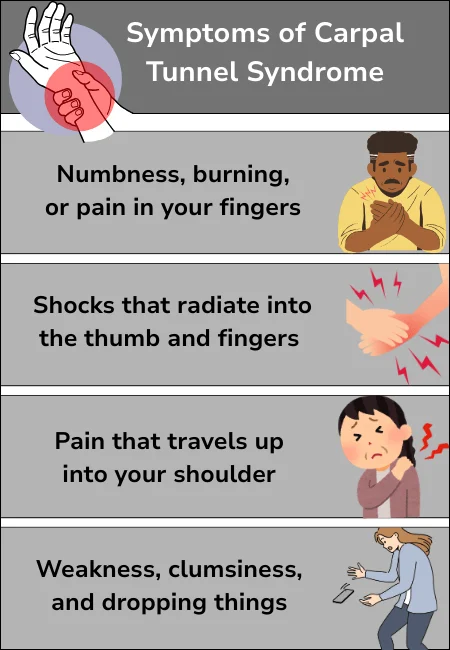If symptoms from your carpal tunnel syndrome prevent you from typing or picking up small objects, you might qualify for Social Security disability.
Carpal tunnel syndrome—also called median nerve compression—is a common condition that causes numbness and tingling in the wrist and hands. It happens when the median nerve, which runs down the arm into the hand, becomes compressed at the wrist, usually resulting from inflammation of the connective tissues (tendons) that surround the nerve. Because the median nerve controls sensations to the palm, thumb, and fingers, compression of the nerve makes it harder to control the electrical impulses that tell your fingers and thumb to move.
Some people with carpal tunnel syndrome have mild symptoms that can resolve with rest after a few weeks or months. But others have more severe symptoms that might require surgery and significantly interfere with their ability to use their hands. If you're unable to perform job duties requiring manual dexterity (such as typing, putting small parts together, or grasping objects), you should understand how you can qualify for Social Security disability benefits.
When Is Carpal Tunnel a Disability?
The Social Security Administration (SSA) recognizes that symptoms of carpal tunnel syndrome can prevent you from working full-time. Almost every job imaginable requires you to use your fingers and hands—such as pastry chefs who create intricate designs, surgeons who manipulate precise instruments, bus drivers who turn the steering wheel, and administrative assistants who must type quickly.
When you submit an application for Social Security disability benefits, a claims examiner will review your file to determine whether symptoms from your carpal tunnel syndrome—such as tingling, weakness, and pain in your fingers— prevent you from working for at least twelve months. The examiner will be on the lookout for the following medical evidence in your application:
- diagnostic tests, such as a nerve conduction study, that measure the degree of latency (slowness) based on how long it takes electrical signals to travel through the nerves
- doctors' notes, including any clinical signs of carpal tunnel that appear on examination, such as positive Phalen's or Tinel's signs
- conservative therapies like wrist splinting, physical therapy, or ergonomic changes like getting a different keyboard
- medication management including over-the-counter anti-inflammatories such as naproxen (Aleve)
- corticosteroid injections, and
- carpal tunnel release surgery.
Based on the medical evidence and the details in your function report, the examiner will make an assessment about your residual functional capacity (RFC). Your RFC is a set of restrictions that reflect the most you're capable of doing, physically and mentally, in a work environment. Social Security is required to address all your combined medical conditions in your RFC, not just carpal tunnel syndrome, so make sure to let the agency know about any additional impairments for which you're receiving medical treatment.
What Does an RFC For Carpal Tunnel Syndrome Look Like?
As mentioned above, very few jobs exist that don't require you to use your fingers and hands. For disability applicants with carpal tunnel syndrome, their RFC will almost certainly include restrictions on how long they can use their arms, hands, and fingers to grasp, hold, and press objects. In Social Security lingo, these restrictions are called manipulative limitations.
Manipulative limitations are categorized further into fine and gross manipulation. Fine manipulation consists of movements that you do with your fingers, such as typing or pressing buttons. Gross manipulation consists of movements that you do with your whole hand, such as grasping a mug or turning a doorknob. The SSA classifies manipulative limitations according to how long you can perform the activity in a workday:
- Constant manipulation requires you to use your hands up to 100% of the time.
- Frequent manipulation requires you to use your hands up to two-thirds of the time.
- Occasional manipulation requires you to use your hands up to one-third of the time.
- Rare manipulation requires you to use your hands up to 10% of the time.
The more severe your carpal tunnel symptoms are, the more restrictive your manipulative limitations will be. For example, a claimant with mild carpal tunnel syndrome may have an RFC that limits them to frequent gross manipulation, while another claimant with severe symptoms despite a carpal tunnel release may be restricted to only occasional fine and gross manipulation.
You can greatly improve your chances of getting disability benefits for carpal tunnel syndrome if you have a medical source statement from your doctor. The statement should include your doctor's opinion on how long you can use your hands during the day, using specific numbers like "2 hours total," or "50% of the time." If your doctor's opinion isn't at odds with the rest of your medical records as a whole, Social Security is more likely to include their specific limitations in your RFC.
How Does Social Security Use Your RFC?
Social Security will compare your RFC with the duties of your past jobs to see if you could still do them today. If you can't do any of your past work, then the agency will determine whether you're able to perform any other jobs in the national economy. If your carpal tunnel symptoms rule out all past and current work, the SSA will approve your application for disability benefits.
For claimants under the age of 50, this generally means that you'll need to prove that you can't do the simplest, sit-down jobs in order to qualify for disability benefits. Because most sit-down jobs by their nature require you to use your hands at a constant, if not frequent, level, if you can show that your carpal tunnel symptoms are severe enough that you can only use your hands and fingers occasionally throughout the workday, the SSA is unlikely to find that you can perform any job. Whether your symptoms are in your dominant or non-dominant hand also plays a large role in the agency's decision, as you're more likely to qualify for benefits if your symptoms affect your dominant hand.
Claimants 50 years of age or older may have an easier time qualifying for benefits under the medical-vocational grid rules. That's because Social Security takes into account factors such as your education and skill set to decide whether you could be expected to make a career switch before you hit full retirement age. For example, a 58-year-old former concert pianist who can no longer play piano due to carpal tunnel syndrome may be found disabled even if the agency thinks they can physically perform other work.
VA Disability Benefits for Carpal Tunnel Syndrome
Veterans who have service-connected carpal tunnel syndrome may be eligible for disability compensation from the VA. Using the Schedule for Rating Disabilities, you may be assigned a disability percentage rating for carpal tunnel under diagnostic code 8515, "Paralysis of the Median Nerve." Your rating will correspond to the degree of nerve damage in your hand and the functional limitations it causes.
Complete paralysis of the median nerve warrants a 70% rating, and is indicated by signs of significant nerve damage such as being unable to make a fist or move your thumb laterally. Incomplete paralysis of the median nerve can get you a disability rating of 50% (if severe), 30% (if moderate), and 10% (if mild). Your rating percentage plays a large role in determining the monthly amount you'll receive in disability benefits, so make sure to check your C-file to confirm that the VA has all the medical records it needs to make a proper assessment.
How Much Disability Will I Get for Carpal Tunnel Syndrome?
Social Security doesn't award benefits based on the type of disabling condition. Instead, the amount you'll receive if you're awarded benefits will depend on whether you're eligible for Social Security Disability Insurance (SSDI) or Supplemental Security Income (SSI). SSDI eligibility is determined by your work history and how much you've contributed to the program in payroll taxes, while SSI is a needs-based benefit available to people with limited resources.
For 2025, the maximum you can receive in SSDI benefits is $4,018 per month (although the average amount is much lower, at $1,580). SSI benefits are tied to the federal benefit rate, which in 2025 is $967 per month minus any countable income you have in that month. You can learn more in our articles on how much you can get in SSDI and how much you can get in SSI. Veterans can visit the VA webpage listing the current disability compensation rates to see how much they can get every month based on their disability rating and living situation.
Applying for Disability Benefits
Filing for Social Security benefits is fairly straightforward. You can start your application for disability benefits in one of several ways:
- Go online at ssa.gov. Filing online has many benefits, such as giving you the option to save your application and return to it later. You'll also receive a confirmation number where you can track your application.
- Call Social Security's national number at 800-772-1213 from 8:00 a.m. to 7:00 p.m., Monday through Friday, to speak with a representative. If you're deaf or hard of hearing, you can use the TTY number at 800-325-0778.
- Apply in person at your local Social Security field office. You can use the locator tool here to find the office closest to you.
You can learn more in our article about filing a disability application with Social Security. Veterans seeking disability compensation can find comprehensive information about applying in our article on how to file for VA benefits.
Whether you're filing for benefits with the SSA or the VA, you aren't required to have an attorney at any stage of the disability determination process. However, it's often a good idea—especially if you think you need to make a carpal tunnel injury claim or have a hearing scheduled with an administrative law judge. An experienced disability lawyer can help you establish the functional limitations you'll need to get a higher VA percentage rating or a more restrictive RFC. Disability lawyers don't get paid unless you win and many offer free consultations, so there's little risk in hiring one early on in the process.


